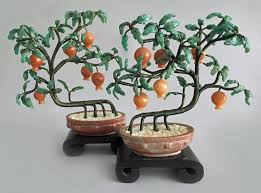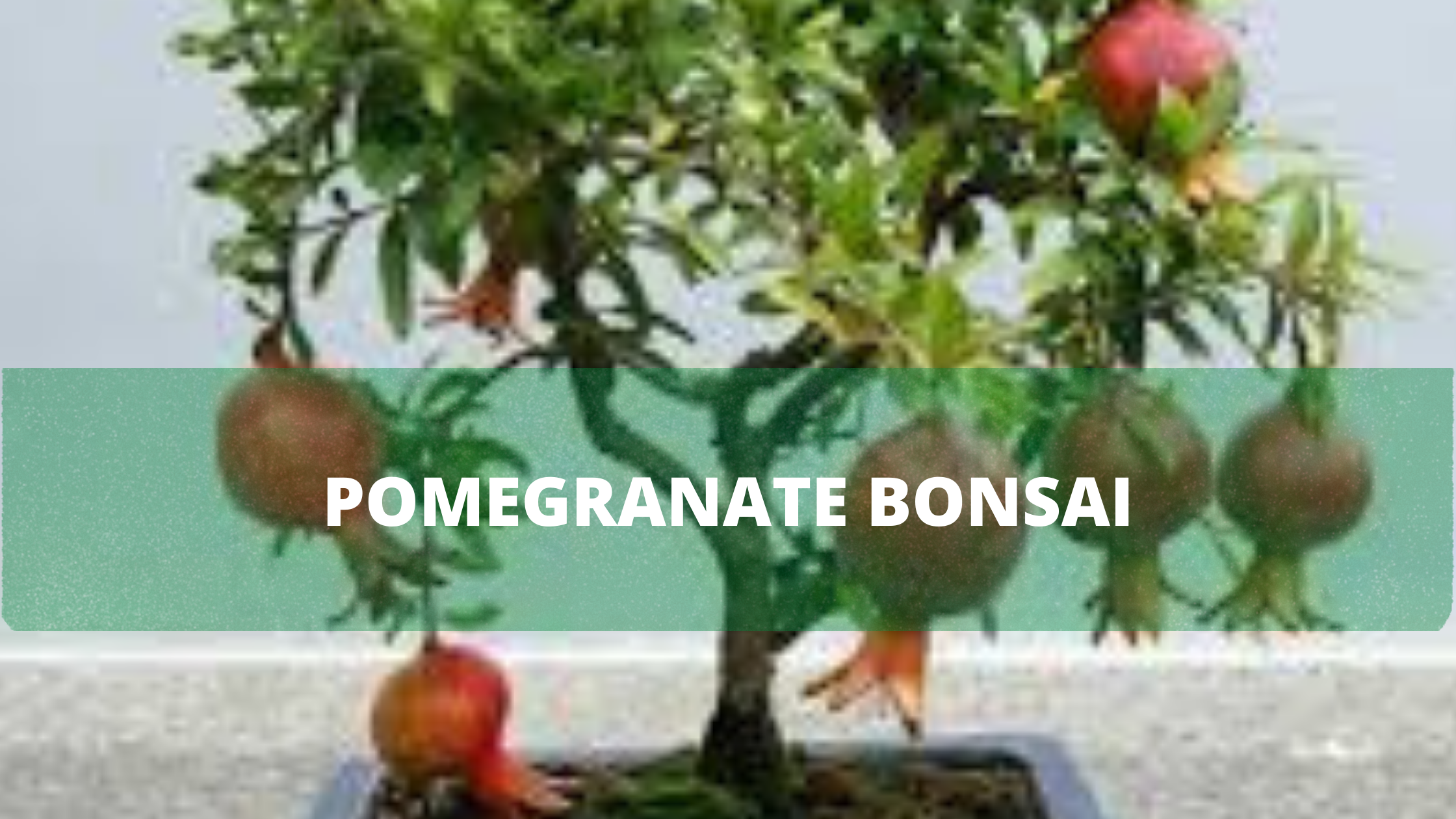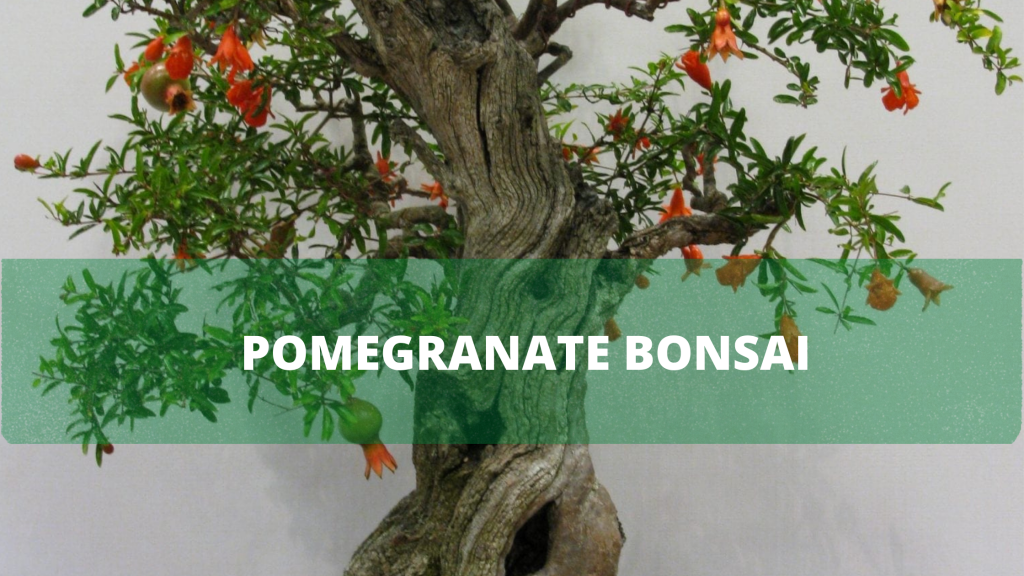Pomegranate Bonsai
The pomegranate bonsai is a beautiful and delicate plant that can be very difficult to care for. It needs to be repotted yearly in the springtime, with soil that’s been mixed with sand and organic matter such as peat moss. It also requires watering every day during the summer months, but not so much during winter.
But with all this said, you should not be put off growing a pomegranate bonsai.
Here’s some tips to growing this bonsai tree and how you should care for it to ensure you have a great bonsai.
But first….
History of the pomegranate bonsai tree

The pomegranate bonsai tree is an ancient plant which has been around for centuries.
It’s believed to have originated in China but since then has found its way around the world and has grown quite popular in America, Australia, England, New Zealand etc.
How to grow a pomegranate bonsai tree from seed.
If you want to grow a pomegranate bonsai from seed, then this is how you do it.
You need:
Seeds (Some seeds may take up to 2 years to germinate)
Seed tray or flat
The first step is to fill the seed tray with potting compost. Place a layer of roughly 5mm across the base of the tray and sprinkle your seeds on top.
You can grow several plants from one batch if you wish but keep track of the seeds as each pomegranate variety is unique.
Water the seeds until they’re covered, wait for a few minutes and then drain away any excess water from them.
Many people say you shouldn’t cover pomegranate seeds with anything because it could mean they don’t germinate but if you have a problem with slugs who like to munch on seeds, then you may consider covering them.
Your pomegranate seeds will most likely germinate in approximately one or two weeks with all the right conditions. Once they’ve started growing; give them plenty of water but never let the compost become soggy and allow the soil to drain well.
Where to grow your bonsai tree
It’s best to grow your seeds in natural conditions outdoors if possible. If you can’t do this then a south facing window sill will be good enough for them to grown healthy.
The pomegranate bonsai tree needs lots of sunlight so never try and take it outside during winter months, let the plant rest indoors until the following Spring.
You also need to water your pomegranate bonsai daily in the summer if you can. It’s very easy for these plants to get sunburnt so always remember this when watering and ensure you don’t over do it.
They also need a lot of heat, so be careful where you place them because a draft could kill your plant.
Pomegranate bonsai from a cutting.
If you want to grow a pomegranate bonsai from a cutting then it’s best to take the cutting in Autumn time.
Boil some water and fill a pot, allow the water to become room temperature before transplanting your cutting into the potting compost.
Place a humidity dome over top of your pomegranate plant, the dome should be made of plastic or glass with small holes to allow ventilation.
The cutting will require lots of humidity and warmth to survive so place the pot near a window where it will get plenty of sunlight during Winter months, you’ll start seeing roots in around 5 weeks time.
Once you have some roots on your plant they can be transplanted into their own pot, leave plenty of room for growth.
It’s best to let the plant grow in its new pot for around one year before styling or pruning it and remember; lots of sun and nutrient rich soil for healthy leaves and stems.
How often should you water your pomegranate bonsai?
It’s best to keep your soil moist at all times. You should never let it dry out completely. You can’t leave it sitting in water so you should always try to keep the soil moist. Make sure you don’t overwater it though because too much water can kill your plant.
When your Pomegranate tree starts drooping or dropping leaves, then this is an indication that it needs more water. But if they are yellow and falling off on their own (which means they are old and about to die), then this is a sign of overwatering.
If it’s summer time, you should water your pomegranate bonsai trees more often because they lose moisture through their leaves and need more water at this time of the year. Plus the sun tends to dry out the soil more often.
Make sure to water your pomegranate bonsai tree around two times a week depending on the time of the year and how hot it is outside (they lose moisture through their leaves). If you live in an area where it’s always warm and sunny, then you might have to water your bonsai trees more often.
How to water your pomegranate bonsai tree?
Pour water slowly into the soil and make sure that all parts of the soil are moistened . You can use a finger or a stick to check how dry it is inside. If you’re seeing lots of cracks, then it might be time for you to water it.
Watering your pomegranate bonsai tree.
Pomegranate bonsai trees are known to be very drought tolerant but it’s still best to water them regularly.
Water the plant until the compost is wet, don’t allow your pomegranate bonsai to become dry or you could kill the whole plant before you know what’s happened.
Never let your pomegranate bonsai dry out completely, always try and water it when the soil is slightly dry because this will prevent root rot.
What soil should I use for my pomegranate bonsai?

You need to make your own special mix of potting soil. You can buy commercial soils but these are usually too heavy for this bonsai tree. What you want is a mix with good drainage otherwise the roots will rot away and fall off.
You can buy commercial bonsai soils but it’s best to make your own for this tree.
You’ll need:
– 1 part coarse sand (washed and sterilized)
– 1 part peat moss (or natural compost if you have any available)
– 2 parts soil mix (you can use garden or potting soil to mix with the other ingredients)
If you have any other extra things you can add to this mix (like vermiculite, pine bark etc.) then feel free too. But make sure it’s not wet and soggy like many bonsai growers do or your pomegranate roots will drown.
How should you repot your pomegranate bonsai?
Pomegranates don’t often need to be repotted but if they do, then you should use the spring months before new leaves appear. But again; only if necessary.
It’s best to take out up to 50% of the soil from under the plant and replace with fresh bonsai soils. If you’re not sure whether to do this or not, then leave it for another year.
What pests can attack my pomegranate bonsai?
Pests that affect the pomegranate tree are aphids (they look like tiny green scales), mealybugs (look like small cotton balls on branches and stems) and other tiny insects that suck the life out of your plant.
If you want to treat these pests, then there’s several products that can help:
– Neem Oil (you should always buy organic Neem oil for every type of bonsai tree because it works well against most pests)
– Insecticidal soap (you can buy this in any garden store)
– Mix both of these ingredients in a spray bottle and use it when needed. Make sure the soil is moist before you apply them or they won’t be very effective.
Pomegranate bonsai care
This is easy once you get to know the plants requirements. And one day when you decide to share your masterpiece with friends or family, they’ll be in awe of this beautiful bonsai which is full of life and color.
Fertilizing your pomegranate bonsai
Pomegranate bonsai trees like to eat fertilized soil with potassium and phosphorous. You can buy commercial fertilizers at any garden centers or hardware stores that are specifically for bonsai use.
Best fertilizer for your pomegranate bonsai tree
As already mentioned the best fertilizer is one that has Potassium and Phosphorous in it.
You can also use organic fertilizers or compost tea . Water it into the soil with a spray bottle every time you water your bonsai plants. This will give them everything they need to grow healthy, bright leaves.
If you want to be extra caring about your Pomegranate bonsai tree, then make sure to add this fertilizer in the fall and winter months and around every six weeks (or when your leaves start changing colour).
Pomegranate bonsai pruning
The best time to prune your pomegranate bonsai tree is before the spring. You can take off any branches that are dead or dying and you can also encourage new growth by pinching off some of the leaves.
Remember not to over do it because too much sun will burn them away. Also make sure they get enough water so the leaves don’t crinkle and curl up.
Can you grow pomegranate bonsai trees indoors?
You can grow them indoors but they need a lot of sunlight so you should always place them near windows where there’s lots of natural light. If not, then your plant might start dropping leaves or turning yellow on its own.
Pomegranate bonsai tree for sale
If you want to buy a pomegranate bonsai tree then there’s few places where you can get one:
– Local garden stores (but not always because they sell them seasonally). Check out The Bonsai Man, Keperra, Brisbane.
– Online through Amazon or eBay
– Bonsai Clubs and Nurseries in your area
You should always do your research before buying a pomegranate bonsai tree especially if you’re new to caring for bonsais because some of them are poisonous.
Conclusion
The pomegranate bonsai is a beautiful and healthy plant that can be grown indoors. It’s hard to grow, but once you know how it grows, the process becomes easier. You’ll need patience and luck for this one!
Some people like to grow pomegranate bonsais as a hobby and they can be grown indoors or outdoors. Pomegranates are also eaten fresh, juiced, dried in slices called arils, made into jelly and juice concentrate.
Be sure to check out our blog post on growing your own pomegranate bonsai tree if you’re interested in adding some beauty and health into your life.
Have you done our free BONSA course? Check it out today. It’ll help you with growing better bonsais

